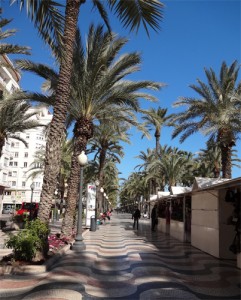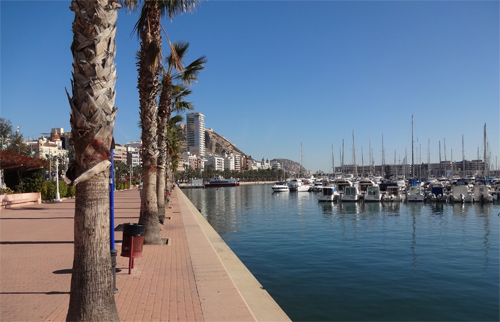The capital of Alicante Province and the second largest city in the Region of Valencia, the historic port-city of Alicante has redeveloped itself in recent decades into a popular tourist spot thanks to its proximity to Alicante airport and its gorgeous Mediterranean beaches. There is plenty to do here, rain or shine.
Just to the north of the port and in the heart of the city are the sandy shores of Playa del Postiguet. Behind the beach is a palm-shaded promenade which is lined with shops, cafes, bars, restaurants and places to rent loungers and parasols.

View Alicante City & Beach in a larger map
Overlooking Alicante city is Santa Barbara castle. Sat atop Benacantil Mountain, 166 metres above sea level, and with views of almost the whole of Alicante bay, it’s easy to see the strategic value of this Moorish construction. Though built in the late ninth century by the Moors, sections of the castle were added in the sixteenth, seventeenth and eighteenth centuries. The castle is free to visit and can be accessed by car or foot via the road that winds its way up the back of the mountain. There is also elevator access, for a fee, opposite Postiguet beach.

Within the castle walls are dungeons, a moat, cannons and armouries. The castle also runs exhibitions. ‘Elements of Torture and Death’ reveals the gruesome methods of Middle Ages torture and displays cages and contraptions used during the Spanish Inquisition. Also currently (July 2013) on display are the Treasures of Villena, described as one of the most important finds of Bronze Age gold. Comprised of over 50 objects the haul of gold, silver, iron and amber weighs around 10 kilos. If you’re visiting with kids or if you are a big kid, visit the Playmobil exhibition (running until 26th March 2014) which details the history of Alicante from its beginnings right through to the present day using more than 1000 Playmobil figures.
On the south side of Benacanti Mountain is Alicante’s Old Town with its narrow streets and many beautiful old buildings including the 18th century town hall. There is plenty to do here from visiting the city’s museums which include Museum of Contemporary Art of Alicante (MACA) and the museum of 20th Century art donated to the city by the Spanish sculptor, painter and graphic artist Eusebio Sempere. There are many restaurants and bars here too where you can relax and enjoy the atmosphere.
Just in front of the Old Town is the port and between the two runs the so-called “the soul of the city”, the Paseo Explanada de España, a palm-lined promenade wrapped around the marina. Its distinctive wave patterned walkway, representing the Mediterranean Sea, stretches for 800m and is made up of over 6 million coloured tiles. Do as the locals do and take an evening stroll. This is a favourite meeting place: of an evening friends, families, couples will amble along the shaded walkway. Wooden benches line the route so you can simply sit and watch the world go by. Along the promenade are ice cream parlours, coffee shops and stalls selling handicrafts. Through the palm trees you can see the impressive yachts bobbing in the marina.
For more information visit the Alicante website.
Alicante City is Drivalia’s ‘home’ town and just a 15 minute drive from the car hire depot.
 Sweden
Sweden



